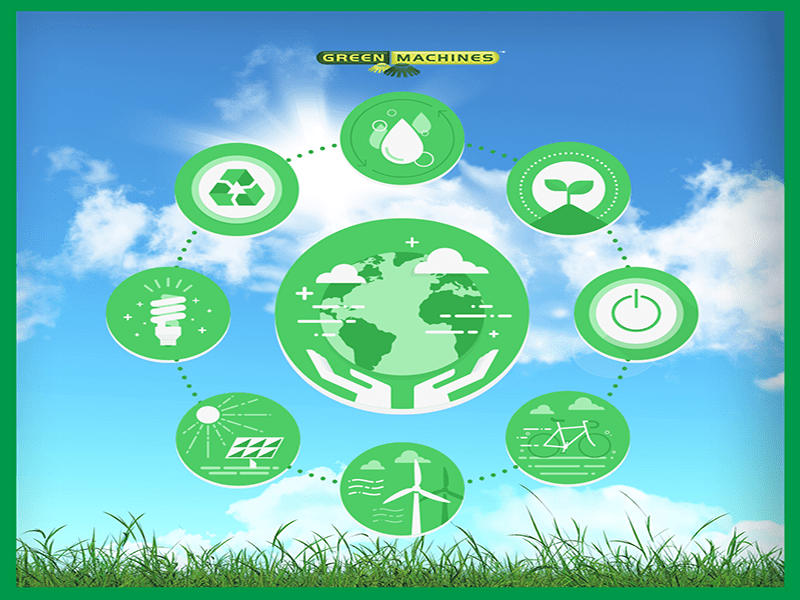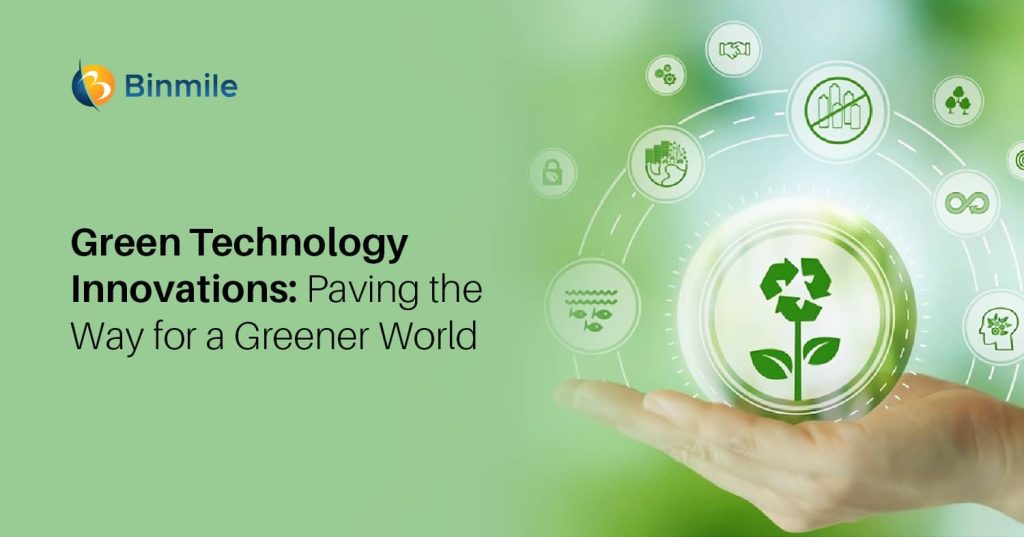So you’ve probably heard about the push for a more eco-friendly future, right? Well, get ready to be blown away by the exciting opportunities that lie ahead! This article is all about how the world is encouraging and embracing future green technology innovations. From renewable energy sources to sustainable transportation solutions, the possibilities are endless. Let’s explore some of the incredible advancements taking place and the potential they hold for a greener, more sustainable future. Get ready to be inspired!
Importance of Green Technology Innovations
Green technology innovations play a crucial role in addressing climate change, reducing environmental pollution, and conserving natural resources. As the world faces the growing challenges of global warming and resource depletion, it has become increasingly important to prioritize sustainable solutions. Green technology offers a pathway towards a more sustainable future by promoting the use of renewable energy, efficient waste management practices, and eco-friendly construction methods. By embracing and investing in green technology innovations, we can contribute to a cleaner and healthier planet for ourselves and future generations.
Addressing Climate Change
One of the primary benefits of green technology innovations is their ability to mitigate climate change. The burning of fossil fuels for energy production is a major contributor to greenhouse gas emissions and global warming. By transitioning to renewable energy sources such as solar, wind, and hydropower, we can significantly reduce carbon emissions and combat climate change. Green technology also encompasses carbon capture and storage techniques, which help capture and store carbon dioxide emissions from industrial processes, further reducing their impact on the environment.
Reducing Environmental Pollution
Traditional industrial practices often lead to significant environmental pollution, including air and water pollution, as well as soil contamination. Green technology innovations aim to minimize or eliminate these harmful impacts by implementing cleaner and more sustainable alternatives. For instance, the use of electric vehicles instead of gasoline-powered cars helps reduce air pollution and improve overall air quality. Additionally, advanced waste-to-energy technologies ensure more efficient waste management and reduce landfill waste, preventing pollution and greenhouse gas emissions.
Conserving Natural Resources
The depletion of natural resources is a critical issue that needs urgent attention. Green technology plays a vital role in conserving these resources and promoting sustainable practices. By incorporating energy-efficient technologies in buildings and implementing smart city planning, we can reduce energy consumption and preserve valuable resources. Furthermore, innovations in water conservation and management can help mitigate the impact of water scarcity and ensure its sustainable use. Green technology also encourages the adoption of circular economy strategies, which prioritize reducing, reusing, and recycling materials, thereby minimizing resource extraction and waste generation.
Government Initiatives and Policies
Government initiatives and policies play a pivotal role in driving the adoption and implementation of green technology innovations. They provide the necessary framework and support to encourage businesses and individuals to embrace sustainable practices. Some key government initiatives include:
Implementation of Renewable Energy Targets
Governments across the world are setting renewable energy targets to increase the share of clean energy in their overall energy mix. These targets provide a clear roadmap for energy generation from renewable sources such as solar, wind, geothermal, and biomass. By establishing these targets, governments create a favorable market and regulatory environment that stimulates investment in renewable energy projects.
Providing Financial Incentives
To further incentivize the adoption of green technology, governments often provide financial incentives, such as grants, tax credits, and subsidies. These incentives help reduce the initial cost barriers associated with implementing sustainable solutions and promote wider adoption. For example, homeowners and businesses installing solar panels may be eligible for tax credits, making solar energy more economically viable.
Supporting Research and Development
Government support for research and development (R&D) in the field of green technology is crucial for fostering innovation and driving advancements. Grants and funding programs provided by governments help researchers and scientists develop new technologies, improve existing ones, and tackle key environmental challenges. These R&D initiatives contribute to the growth of the green technology sector and facilitate its integration into various industries.

Role of Education and Awareness
In order to foster the widespread adoption of green technology innovations, it is essential to educate and create awareness among individuals and communities. Education has a significant role to play in shaping mindsets and preparing the next generation for a sustainable future. Here are some key aspects of education and awareness:
Including Green Technology in Curriculum
Integrating green technology topics into educational curricula at various levels is crucial for building a generation that is well-versed in sustainable practices. By teaching young students about the importance of renewable energy, waste reduction, and eco-friendly lifestyle choices, we can instill values that prioritize sustainability. This education can help shape future decision-makers who will drive green technology innovations.
Organizing Workshops and Seminars
Workshops and seminars provide opportunities for individuals to learn about green technology innovations firsthand. These events bring together experts, professionals, and enthusiasts who can share knowledge, experiences, and best practices. Workshops and seminars also facilitate networking and collaboration, helping individuals and organizations connect and exchange ideas.
Promoting Sustainable Practices
Creating awareness about sustainable practices and eco-friendly alternatives is essential for realizing the full potential of green technology innovations. Campaigns and outreach programs can be organized to educate the general public about the benefits of renewable energy, waste management, and sustainable transportation options. By promoting sustainable practices, we can encourage individuals and businesses to adopt green technologies and contribute to a greener future.
Collaboration between Industries and Academia
Collaboration between industries and academia is crucial for driving green technology innovations. By working together, they can leverage their respective expertise, resources, and networks to accelerate the development and implementation of sustainable solutions. Here are some ways in which industries and academia can collaborate:
Joint Research and Development Projects
By collaborating on research and development projects, industries and academia can pool their knowledge and expertise to develop innovative green technologies. These projects often involve joint funding, shared facilities, and the exchange of scientific findings. For example, a partnership between a renewable energy company and a university’s engineering department could lead to the development of more efficient solar panels or wind turbines.
Fostering Innovation Hubs
Creating innovation hubs or centers that bring together researchers, entrepreneurs, and industry leaders can foster collaboration and accelerate the development of green technology innovations. These hubs act as platforms for exchanging ideas, conducting experiments, and transforming research into commercially viable solutions. By creating an environment that encourages entrepreneurship and innovation, these hubs drive the growth of the green technology sector.
Sharing of Knowledge and Resources
Industries and academia can benefit from sharing their knowledge, skills, and resources. Industry experts can provide practical insights and real-world challenges, while academia can offer scientific expertise and research capabilities. By collaborating and sharing resources, both parties can work together to overcome technological barriers and accelerate the adoption of green technology innovations.

Investment in Green Startups
Investing in green startups is crucial for nurturing and supporting the development of sustainable technologies and businesses. Startups often possess the agility and innovative mindset required to disrupt traditional industries and drive green technology innovations. Here are some ways in which investment can support green startups:
Providing Funding Opportunities
Financial investment plays a vital role in allowing green startups to develop and scale their innovative solutions. Venture capital firms, angel investors, and government funding programs can provide the necessary capital for startups to enhance their research and development efforts, commercialize their technologies, and expand their operations. This funding support enables startups to bridge the funding gap and navigate the early stages of business development.
Incubation and Acceleration Programs
Incubators and accelerators provide comprehensive support to startups, including mentorship, resources, and access to networks. Green startups can benefit from joining these programs specifically tailored to the green technology sector. Incubators and accelerators often have a strong network of industry partners, investors, and experts who can guide startups on their journey to success.
Venture Capital Support
Venture capital firms play a crucial role in providing long-term investment and guidance to green startups. These firms are focused on supporting the growth of sustainable technologies and businesses. By investing in promising startups, venture capital firms help them scale their operations, enter new markets, and realize their full potential. Additionally, these investments can attract further funding and partnerships, creating a positive cycle of growth and innovation.
Technological Advancements in Green Energy
Technological advancements in green energy have revolutionized the way we generate and utilize renewable energy. These advancements have made renewable energy sources more efficient, cost-effective, and accessible. Here are some key areas of technological advancements in green energy:
Solar Power Innovations
Solar power has seen significant advancements over the past decade. Photovoltaic (PV) panels have become more efficient, allowing for greater energy generation from the same surface area. Additionally, researchers are exploring new materials, such as perovskite solar cells, which have the potential to further increase the efficiency of solar panels. Furthermore, innovations in solar energy storage and grid integration technologies enable better utilization of solar power, ensuring a constant and reliable supply of renewable electricity.
Wind Energy Solutions
Advancements in wind turbine technology have resulted in larger and more efficient turbines, capable of harnessing more wind power. These turbines now have taller towers and longer blades, which capture more wind energy at higher altitudes. Moreover, the development of offshore wind farms allows us to tap into the vast wind resources available at sea. Innovations in turbine design, control systems, and maintenance techniques have also improved the reliability and performance of wind energy systems.
Energy Storage Breakthroughs
Energy storage technologies have a vital role to play in the integration and utilization of renewable energy sources. Advancements in battery technologies, such as lithium-ion batteries, have made energy storage more efficient, durable, and cost-effective. These batteries allow for the storage of surplus energy generated by renewable sources, which can be utilized during periods of high demand or low generation. Additionally, emerging technologies like flow batteries, hydrogen storage, and compressed air energy storage are being developed to further enhance energy storage capabilities.

Green Transportation and Mobility
The transportation sector is a significant contributor to greenhouse gas emissions and air pollution. Green technology innovations in transportation and mobility aim to reduce these impacts and promote more sustainable alternatives. Here are some key areas of focus:
Electric Vehicles
Electric vehicles (EVs) have emerged as a viable alternative to traditional gasoline-powered cars. With improvements in battery technology and charging infrastructure, EVs have become more practical and accessible for the average consumer. They offer zero tailpipe emissions, reducing air pollution and dependence on fossil fuels. The development of fast-charging stations and longer-range batteries further enhances the convenience and feasibility of EVs.
Biogas and Biofuel Technologies
Biogas and biofuels derived from organic waste and agricultural byproducts provide an environmentally friendly alternative to conventional fossil fuels. Biogas can be used to power vehicles directly or converted into biomethane for injection into natural gas pipelines. Biofuels, such as ethanol and biodiesel, can be used as a blend with gasoline or diesel in existing vehicles, reducing their carbon footprint. These sustainable transportation fuels help reduce greenhouse gas emissions and promote the efficient use of organic waste resources.
Smart and Sustainable City Planning
Green technology innovations also extend to urban planning, with a focus on creating smart and sustainable cities. This involves designing cities in a way that promotes walking, cycling, and the use of public transportation. Smart city technologies, such as intelligent traffic management systems and real-time public transportation tracking, help optimize transportation networks and reduce congestion. Sustainable city planning also emphasizes the integration of renewable energy sources, energy-efficient buildings, and green spaces, creating more livable and environmentally friendly urban environments.
Waste Management and Recycling Innovations
Efficient waste management and recycling are essential for reducing the environmental impact of waste and maximizing resource recovery. Green technology innovations in this area aim to optimize waste management processes and support a circular economy. Key innovations include:
Circular Economy Strategies
Circular economy strategies prioritize reducing waste generation, reusing materials, and recycling as much as possible. Green technology innovations play a crucial role in enabling the implementation of these strategies. Advanced sorting and recycling technologies allow for the efficient separation and recovery of valuable materials from waste streams. Additionally, waste-to-energy technologies ensure the conversion of non-recyclable waste into energy, reducing the reliance on fossil fuels and minimizing landfill waste.
Advanced Waste-to-Energy Technologies
Waste-to-energy technologies provide a sustainable solution for managing organic waste and generating renewable energy. Anaerobic digestion and gasification processes can convert organic waste into biogas or syngas, which can be utilized for heat and power generation. These technologies not only reduce the environmental impact of waste but also contribute to renewable energy production. Advanced waste-to-energy systems capture harmful emissions and utilize them in an environmentally friendly manner, further minimizing the impact on air quality.
E-waste Management Solutions
The rapid advancement of technology has led to a significant increase in electronic waste (e-waste). Green technology innovations focus on developing efficient and environmentally sound solutions for e-waste management. These solutions encompass techniques for the safe and responsible recycling and disposal of electronic devices. Innovations include automated e-waste sorting systems, safe material recovery processes, and the implementation of extended producer responsibility programs that incentivize manufacturers to design and produce more sustainable electronic products.

Green Building and Architecture
Green building and architecture aim to create structures that are energy-efficient, environmentally friendly, and sustainable. Green technology innovations in this field contribute to reducing the environmental impact of buildings and promoting resource conservation. Key areas of focus include:
Energy-Efficient Construction Methods
Green building practices prioritize energy efficiency from the design and construction stage. Innovations in construction materials, such as advanced insulation materials and high-performance windows, help reduce energy consumption for heating, cooling, and lighting. Additionally, technologies like building energy management systems and smart thermostats optimize energy usage within buildings, further enhancing efficiency.
Green Materials and Design
The use of sustainable materials and environmentally friendly design principles is a critical aspect of green building and architecture. Innovations in green materials include the development of eco-friendly alternatives to traditional construction materials, such as low-carbon concrete and recycled building materials. Additionally, green design principles prioritize natural lighting, ventilation, and passive heating and cooling techniques, reducing the reliance on artificial energy sources.
Integration of Renewable Energy Systems
Green technology innovations enable the seamless integration of renewable energy systems into buildings. Solar panels, wind turbines, and geothermal heating and cooling systems can be incorporated into the design and construction of buildings, providing on-site renewable energy generation. These renewable energy systems not only reduce the environmental impact of buildings but also contribute to energy independence and resilience.
Public-Private Partnerships for Green Initiatives
Public-private partnerships (PPPs) bring together government entities, private businesses, and other stakeholders to collaborate on green initiatives. These partnerships leverage the strengths and resources of each party to drive sustainable solutions. Key aspects of public-private partnerships for green initiatives include:
Collaborative Research and Implementation
PPPs facilitate collaborative research and development projects, where the expertise of both the public and private sectors can be combined to develop and implement green technologies. By working together, these partnerships accelerate the adoption of sustainable solutions and drive innovation in areas such as renewable energy, waste management, and transportation.
Joint Funding Opportunities
Government entities and private businesses can pool their financial resources to fund green initiatives. This joint funding approach ensures that sustainable projects receive the necessary financial support to succeed. By leveraging both public and private funding sources, PPPs can support a wide range of initiatives, from research and development to large-scale deployment of green technologies.
Sharing Best Practices
PPPs create opportunities for the exchange of knowledge, experiences, and best practices between the public and private sectors. By sharing insights and lessons learned, these partnerships promote the adoption of successful approaches and avoid duplicating efforts. This knowledge exchange helps drive continuous improvement and ensures that green initiatives are implemented effectively and efficiently.
In conclusion, the importance of green technology innovations cannot be overstated. They provide solutions to address climate change, reduce environmental pollution, and conserve natural resources. Government initiatives and policies play a vital role in supporting the development and adoption of green technologies through renewable energy targets, financial incentives, and research support. Education and awareness help create a sustainable mindset among individuals and communities, while collaboration between industries and academia fosters innovation and knowledge sharing. Investment in green startups drives technological advancements and facilitates the transition to a greener economy. Technological advancements in green energy, green transportation, waste management, green building, and public-private partnerships further contribute to the growth and impact of green technology innovations. By embracing these innovations, we can collectively create a sustainable future for ourselves and generations to come.











